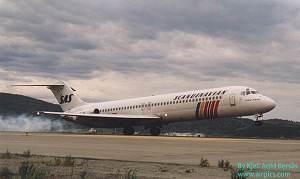11. LANDING. We are established on the localizer and the glidepath starts to move from above. In
the horizon the glidepath is shown as a small triangle on the right. The autopilot
will capture the glide and we can tell the approach controller:
We are established on the localizer and the glidepath starts to move from above. In
the horizon the glidepath is shown as a small triangle on the right. The autopilot
will capture the glide and we can tell the approach controller:Scandinavian 149 established ILS. The ATC will hand us over to the tower. As soon as we start to descent on the glide, we lower the gear extend flaps to 15. (This is normally done at the same time). On the tower frequency we will get cleared to land, and also RVR values. RVR. Runway Visual Range (RVR) is defined as the range over which the pilot of an aircraft on the center line of a runway can see the runway surface markings or the light delineating the runway or identifying its center line. RVR is measured at three positions along the runway. The tower will give us all three readings, ex. 300/400/350. The lowest required visibility is 300m, and we need this for the first segment only. The second and third value is for guidance only. There is also a crosswind limit of 10 knots. The decision height (DH) is measured on the radio altimeter in an CAT II landing. (Normally the decision is measured on the feet altimeter, but then it is called decision ALTITUDE (DA)). The RVR must be at or above our minima, when passing the outer marker or an equivalent position, otherwise we are not allowed to continue the approach. This is valid for every landing regardless of minima. SPEEDSUMMARY. After capture of the localizer, keep flaps 5 and 200-210 kt. Just before glidepath capture, flaps 15 and keep 160 kt to the outer marker (this is standard speed on most airports). Closing the marker extend flaps 25 (you do not have to reduce to idle power, the speed will drop any how. When passing the marker, flaps full (40), and final approach speed according to speedbooklet. In FS98, I normally use 140 kt on final approach. When close to the threshold I start to reduce, passing the threshold at 130 kt. Idle power at 30 feet and rotate to reduce the descent speed. Since all aircraft in FS is flying around width the noose to high, I use SHIFT 5 to get a better wiev. In the approach I use SHIFT 5 two times as standard (sometimes even 3). This will give a wiev forward more close to that in the real aircraft. MINIMA. Normally the minima in an approach is based on the feet altimeter (it is called decision altitude DA). However in CAT II and CAT III we use the radio altimeter instead (called decision height DH). In this case 110 feet. The min vis must be OK when passing OM, but there is also a max crosswind component, in a CAT II, of 10kt when passing decision height. Besides, left pilot must perform the approach and landing. So, from plus 100, in this case 210ft, the L/P will look out while the R/P stay on instruments. STABILIZED APPROACH. When on final, there are two gates to be passed. One at 1000 ft, the other at 500 ft. This is called the stabilized approach. In IMC, all approaches shall be planned to be stabilized at 1000 ft RH (RadioHeight). All approaches must be stabilized not later than at 500 ft RH. If not stabilized passing 500 ft RH a go-around must be ordered. Parameters to be met with :
Aim at a touchdown point on the center line, approximately 300 m down the runway. The flare shall normally be initiated at 30 to 20 ft. To late or to fast a rotation will most probably result in a firm touchdown. Retard the throttles slowly, so as to reach idle position just before touchdown. Ground spoilers will deploy and you can set the engines in reverse thrust (max 1.60 EPR). Delay brake application to below 80kt if possible. From 60kt forward idle thrust. In FS I use reverse thrust from touchdown to 80kt, from then on only wheel brakes. |
| Go back toFlying the CLASSIC. |